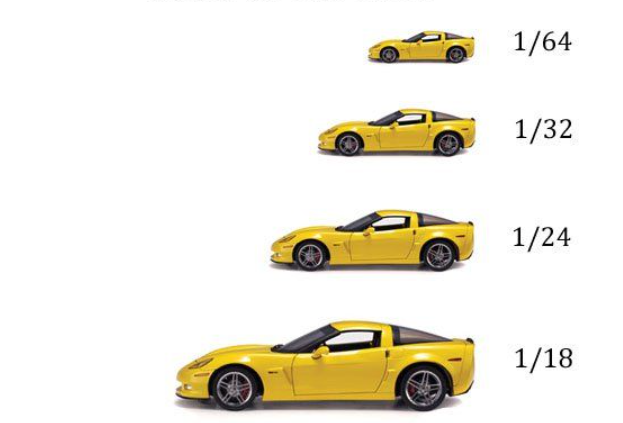There are various different scales available for diecast cars on the market, to choose the right scale, follow us to learn about the common scaled diecast models and what are the differences between them.

What Is the Scale Size of a Diecast Model Car?
The scale size of a diecast model car refers to the ratio of the size of the model car as compared to the actual car it represents. The scale size is usually represented as two numbers separated by a colon (e.g. 1:18 or 1/64). The first number represents the size of the model, while the second number represents the size of the actual car. For example, a 1:18 scale model car means that the model car is 18 times smaller than the actual car it represents. If the actual car is 15 feet long, the 1:18 scale model car would be approximately 10 inches long. Some common scales for diecast model cars include 1:64, 1:43, 1:24, and 1:18. Larger scales tend to have more intricate details, while smaller scales are more affordable and take up less space.
Which Scaled Die-Cast Model Cars Available in the Market? - Die-Cast Car Scales
There are many scaled die-cast model cars available in the market. Some of the most popular scales are:
1. 1:18 Scale – This is a larger scale, with models usually around 9-11 inches long. They are highly detailed and feature opening doors, hoods, and trunks.
2. 1:24 Scale – This is a smaller scale, with models around 6-8 inches in length. They are also highly detailed and can be found with a variety of features such as opening doors, hoods, and trunks.
3. 1:43 Scale – This is a smaller scale and is commonly used for mass-produced models. They are usually around 3-4 inches in length.
4. 1:64 Scale – This is a very small scale commonly used for toy cars and Hot Wheels. Models are usually around 2-3 inches in length and can be highly collectible.
Other scales that can be found in the market include 1:12, 1:32, and 1:87 scales.
What is the most popular scale for diecast cars?
The most popular scale for die-cast cars is 1:64. This scale is commonly used for toy cars, including Hot Wheels and Matchbox, and is also used for a variety of other models. 1:64 scale models are small, usually measuring around 2-3 inches in length, which makes them easy to collect and display. They are also relatively inexpensive compared to larger scales and can be produced in large quantities, making them a popular choice for toy manufacturers. However, larger scales like 1:18 and 1:24 are also very popular among collectors due to their highly-detailed and realistic nature.
What is the difference between 1:24 and 1:18 scale cars?
The primary difference between 1:24 and 1:18 scale cars is their size. A 1:18 scale model car is larger than a 1:24 scale model car. A 1:18 scale car is typically around 9-11 inches in length, while a 1:24 scale car is around 6-8 inches in length. Another difference is the level of detail on the models. Since a 1:18 scale model car is larger, it can have more intricate details and features, such as opening doors, hoods, and trunks, as well as detailed engines and interiors. 1:24 models can also have these features, but the level of detail may not be as high as in the larger scale. The cost of a 1:18 scale model car is typically higher than that of a 1:24 scale model car, reflecting the increased size and level of detail. However, the choice of scale ultimately depends on personal preference, the intended use of the model, and the available space for display.
How to Determine the Diecast Scale?
To determine the scale of a diecast car, there are a few options:
1. Look at the packaging – The packaging of the diecast car may indicate the scale of the model. The scale is often printed somewhere on the packaging or on a sticker attached to the box.
2. Look at the car itself – The scale of the model may be indicated somewhere on the car itself, usually on the underside or on a small label. If the car doesn’t have any indications of its scale on it, a ruler or tape measure can help in measuring its length and then comparing it to standard scale lengths.
3. Find reference materials – There are many online resources that provide information on identifying die-cast car scales, such as collectors’ forums, manufacturer’s websites, and identification guides.
Once the scale of the model has been determined, it can be used to compare its size to other models in the same scale or to decide how it will fit into a collection or display.

